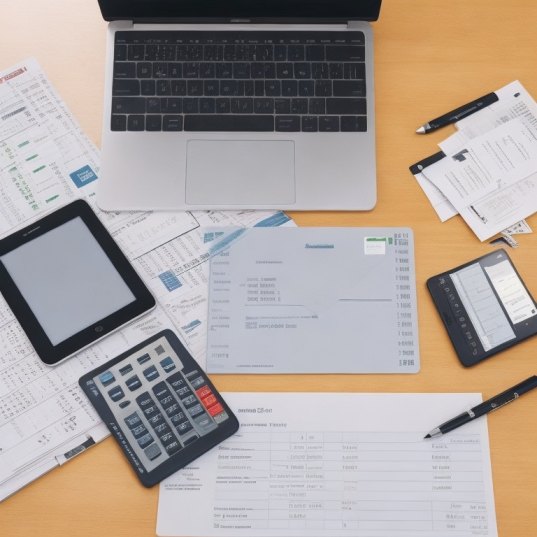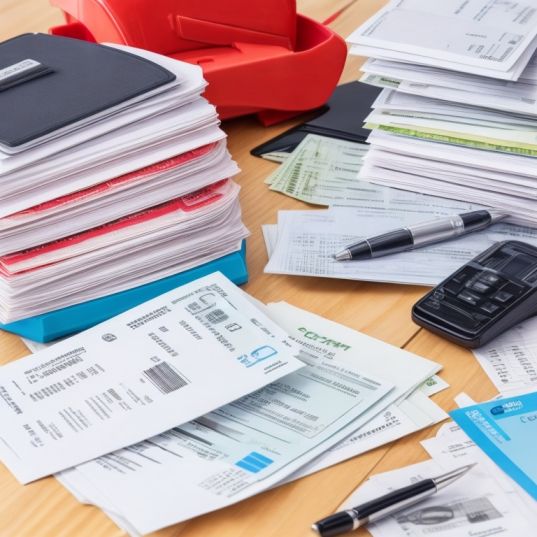Are you ready to take control of your finances and achieve your money goals? Learning how to create a monthly budget for beginners that works is the first step toward financial success. Whether you’re looking to pay off debt, save for a vacation, or simply gain a better understanding of your spending habits, this comprehensive guide will provide you with the essential tools and strategies to build a budget that aligns with your financial goals. Let’s embark on this journey to financial empowerment, where you’ll discover the art of budgeting and how it can transform your financial life.
Understanding Your Financial Situation
Before diving into the nitty-gritty of budgeting, it’s crucial to understand your current financial standing. Start by assessing your income sources. These may include your salary or wages, income from side hustles, or any other sources of revenue.
Next, get a clear picture of your expenses. Categorize them into three main types: fixed, variable, and irregular expenses. Fixed expenses are your regular bills like rent and utilities. Variable expenses encompass things like groceries and entertainment, while irregular expenses might include quarterly bills or occasional medical costs. Calculate your net income by subtracting your expenses from your total income.
Setting Clear Financial Goals
One of the critical building blocks of an effective monthly budget is setting clear and achievable financial goals. These goals act as your financial compass, guiding your spending decisions and helping you stay focused on your priorities. Here’s a detailed breakdown of how to set clear financial goals:
1. Identify Your Goals

The first step in setting financial goals is to identify what you want to achieve. Goals can be categorized into three main timeframes:
a. Short-term Goals:
These are goals you aim to achieve within the next year or less. Examples include building an emergency fund, paying off credit card debt, or saving for a vacation.
b. Medium-term Goals:
These goals typically have a timeline of 2 to 5 years. They might involve saving for a down payment on a home, funding your child’s education, or buying a car.
c. Long-term Goals:
Long-term goals extend beyond 5 years and often involve major life events such as retirement planning, wealth accumulation, or leaving a financial legacy for your heirs.
2. Be Specific and Measurable
Once you’ve identified your goals, make them as specific and measurable as possible. Instead of a vague goal like “save money,” specify how much you want to save and by when. For example, “save $5,000 for an emergency fund within the next 12 months.”
3. Prioritize Your Goals
Not all goals are equal in importance. It’s crucial to prioritize them based on your values and current financial situation. Consider what matters most to you and what will have the most significant impact on your financial well-being.
4. Make Your Goals Realistic
While it’s essential to dream big, your financial goals should also be realistic and attainable. Setting unrealistic goals can lead to frustration and derail your budgeting efforts. Ensure that your goals align with your income and resources.
5. Set a Timeline
Attach a timeline to each goal. This timeframe provides a sense of urgency and helps you stay on track. For example, if your goal is to pay off $10,000 in credit card debt, specify that you aim to achieve this within 24 months.
6. Break Down Large Goals
Large, long-term goals can feel overwhelming. To make them more manageable, break them down into smaller milestones. For instance, if your long-term goal is to save $1 million for retirement, set annual savings targets and celebrate reaching each one.
7. Track Your Progress
Regularly monitor your progress toward your financial goals. Use spreadsheets, budgeting apps, or a simple pen-and-paper system to record your achievements and setbacks. Tracking your progress keeps you accountable and motivated.
8. Adjust as Needed
Life is dynamic, and circumstances change. Be prepared to adjust your goals as necessary. If you encounter unexpected financial challenges or opportunities, don’t hesitate to adapt your goals to your new reality.
9. Stay Committed
Consistency is key to achieving your financial goals. Stay committed to your budget and savings plan, even when faced with temptations or setbacks. Remember the long-term benefits of achieving your goals.
10. Celebrate Milestones
Don’t forget to celebrate your financial victories. Whether it’s paying off a credit card, reaching an emergency fund target, or hitting a savings milestone, acknowledging your achievements keeps you motivated and reinforces positive financial habits.
Creating Your Monthly Budget
Now that you’ve identified your financial goals, it’s time to translate them into a practical plan by creating your monthly budget. This step is crucial in managing your finances effectively and achieving your objectives. Here’s a detailed guide on how to create a monthly budget, along with a short example to illustrate the process:
1. Establish Clear Spending Categories

Start by defining the categories that will structure your budget. Common categories include:
- Essentials: This category covers your basic needs, such as housing (rent or mortgage), utilities (electricity, water, gas), groceries, transportation (car payments, fuel, public transport), insurance premiums, and minimum debt payments (credit cards, loans).
- Non-essentials: These are discretionary expenses that are not strictly necessary for survival. Examples include dining out, entertainment, shopping, subscriptions (streaming services, magazines), and hobbies.
- Savings and Investments: Allocate a portion of your income to savings and investments to meet your financial goals. This can include contributions to an emergency fund, retirement accounts, or a savings account for future expenses.
Example:
- Essentials: Rent ($1,200), Utilities ($150), Groceries ($300), Transportation ($200), Insurance ($100), Minimum Debt Payments ($250).
- Non-essentials: Dining Out ($100), Entertainment ($50), Shopping ($100), Subscriptions ($20), Hobbies ($30).
- Savings and Investments: Emergency Fund ($100), Retirement Savings ($150), Vacation Fund ($50).
2. Determine Your Income
Calculate your total monthly income, including your salary, side hustle earnings, and any other sources of revenue. Ensure you have an accurate figure to work with.
Example:
- Salary: $3,000
- Side Hustle: $500
- Other Income: $200
- Total Income: $3,700
3. Allocate Funds to Each Category
Assign a specific dollar amount to each spending category based on your income and financial priorities. It’s crucial to ensure that your expenses do not exceed your income. Start with your essentials, then move on to non-essentials, and finally, savings and investments.
Example:
- Essentials: $1,200 (Rent) + $150 (Utilities) + $300 (Groceries) + $200 (Transportation) + $100 (Insurance) + $250 (Minimum Debt Payments) = $2,200
- Non-essentials: $100 (Dining Out) + $50 (Entertainment) + $100 (Shopping) + $20 (Subscriptions) + $30 (Hobbies) = $300
- Savings and Investments: $100 (Emergency Fund) + $150 (Retirement Savings) + $50 (Vacation Fund) = $300
4. Prioritize Needs Over Wants
If your expenses exceed your income, you’ll need to make adjustments. Prioritize your needs (essentials) over your wants (non-essentials). Look for areas where you can cut back, such as reducing dining out or entertainment expenses.
Example:
If the total expenses exceeded the income by $100, you might reduce the dining out or shopping budget by $50 to balance your budget.
5. Track Your Spending
Throughout the month, track your expenses diligently. Use a budgeting app, spreadsheet, or a notebook to record every purchase you make. This helps you stay accountable and ensures you’re sticking to your budget.
Example:
You track your expenses and realize you spent $75 on dining out in the first week, which means you have $25 left for the rest of the month to stay within your budget.
6. Review and Adjust Monthly
At the end of each month, review your budget and compare your actual spending to your planned budget. Adjust your budget as needed based on any changes in income or expenses.
Example:
You notice that you consistently spend less on transportation than you budgeted for, so you decide to reallocate that surplus to your emergency fund, increasing your monthly contribution to $125.
Creating a monthly budget is a dynamic process that requires ongoing attention and adjustment. By following these steps and using real figures and examples, you can build a budget that aligns with your financial goals and helps you manage your money effectively. Remember that budgeting is a tool to empower you to make informed financial decisions and work toward financial success.
Using Budgeting Tools and Apps
In today’s digital age, budgeting has become more accessible and efficient than ever, thanks to a plethora of budgeting tools and apps. These resources can help you gain better control over your finances and streamline the budgeting process. Here’s a comprehensive guide on how to use budgeting tools and apps, complete with a short example to illustrate their benefits.
1. Introduction to Budgeting Tools and Apps
Budgeting tools and apps are software or mobile applications designed to simplify the budgeting process. They offer various features to track income, expenses, and savings, providing a comprehensive overview of your financial health.
2. Pros and Cons of Different Budgeting Tools
Before diving into specific apps, let’s explore the advantages and disadvantages of different types of budgeting tools:
a. Spreadsheet Software (e.g., Microsoft Excel or Google Sheets):
- Pros: Customizable, versatile, and can be tailored to your specific needs.
- Cons: Requires manual data entry and may lack automation features.
b. Dedicated Budgeting Apps (e.g., Mint, YNAB, or Personal Capital):
- Pros: Automates transaction tracking, categorizes expenses, and provides real-time financial insights.
- Cons: Some apps may have subscription fees or limited customization.
c. Banking Apps:
- Pros: Many banks offer budgeting features within their apps, making it easy to track transactions and balances.
- Cons: Limited in terms of expense categorization and may not offer a holistic financial overview.
3. Recommended Budgeting Apps for Beginners
Let’s delve deeper into some budgeting apps that are particularly beginner-friendly:
a. Mint:
- Features: Mint connects to your bank accounts, categorizes expenses, and provides a comprehensive view of your financial situation. It also offers goal-setting features.
- Example: Mint can notify you when you exceed your allocated budget for dining out, helping you stay on track with your spending goals.
b. You Need A Budget (YNAB):
- Features: YNAB is a proactive budgeting app that encourages users to allocate every dollar to specific categories. It emphasizes “giving every dollar a job.”
- Example: YNAB can help you allocate funds for an upcoming vacation and monitor your progress toward that goal.
c. Personal Capital:
- Features: Personal Capital offers both budgeting and investment tracking. It provides a holistic view of your financial life, making it suitable for those focused on wealth accumulation.
- Example: Personal Capital can show you how your investment portfolio is performing alongside your budget, helping you align your financial goals.
4. How to Use Budgeting Apps
- Set Up: Download the app, create an account, and link your financial accounts (bank, credit cards, loans).
- Categorize Expenses: Review and categorize your transactions. Most apps offer predefined categories, but you can customize them.
- Set Budgets: Establish monthly spending limits for each category based on your financial goals.
- Track and Analyze: Regularly check the app to monitor your spending, track your progress toward goals, and analyze your financial trends.
Example:
Imagine you’ve set a dining out budget of $200 per month in the Mint app. As you dine out, the app automatically categorizes your restaurant expenses. By mid-month, you receive a notification that you’ve spent $150 on dining out. This alert prompts you to reconsider your dining plans for the rest of the month to avoid overspending.
5. Benefits of Budgeting Tools and Apps
- Automation: Apps streamline data entry by automatically syncing with your bank accounts, reducing manual effort.
- Real-time Insights: Gain instant visibility into your financial health, allowing you to make informed decisions.
- Goal Tracking: Many apps offer goal-setting features, helping you work towards financial milestones.
- Expense Categorization: Apps categorize transactions, making it easy to identify areas where you may need to cut back.
- Accessibility: Access your financial information anytime, anywhere, through your smartphone or computer.
Staying Consistent and Accountable
Consistency is key to budgeting success. Track your daily expenses diligently and conduct a monthly budget review. Be prepared to adjust your budget as needed to accommodate changes in your income or expenses. Discipline and self-control play a vital role in maintaining your budget’s integrity
Building an Emergency Fund: Your Financial Safety Net

Building an emergency fund is a fundamental aspect of personal finance that provides you with a financial safety net when unexpected expenses or emergencies arise. It’s a critical step in achieving financial stability and peace of mind. Let’s explore in detail what an emergency fund is, why it’s essential, and how to build and use it, with examples to illustrate its significance.
1. What Is an Emergency Fund?
An emergency fund is a dedicated savings account or fund set aside to cover unexpected expenses or financial emergencies. It serves as a cushion that allows you to weather unexpected financial storms without resorting to high-interest loans or depleting your long-term savings.
Example: You’re driving to work when your car breaks down suddenly. The repair cost is $1,000, which you hadn’t budgeted for. Instead of going into debt or struggling to find the money, you can dip into your emergency fund to cover the repair bill.
2. Why Is an Emergency Fund Essential?
- Unforeseen Expenses: Life is full of surprises, from medical bills and car repairs to unexpected home repairs or even sudden job loss. An emergency fund ensures you’re financially prepared for these situations.
Example: You or a family member might require medical attention, and even with insurance, there can be out-of-pocket expenses like deductibles, co-pays, or medications that your emergency fund can help cover.
- Avoiding Debt: Without an emergency fund, you may resort to high-interest credit cards or loans when faced with unexpected expenses, potentially leading to long-term debt.
Example: Your refrigerator breaks down, and you don’t have savings to replace it. You end up putting the cost on a credit card, and the interest charges start piling up.
- Peace of Mind: Knowing you have a financial safety net reduces stress and anxiety associated with financial uncertainty.
Example: You lose your job unexpectedly, but having an emergency fund means you can cover your essential expenses while you search for a new position, reducing financial stress.
3. How to Build an Emergency Fund
Building an emergency fund involves the following steps:
- Set a Goal: Determine how much you want to save in your emergency fund. A common recommendation is to aim for three to six months’ worth of living expenses.
Example: If your monthly living expenses are $3,000, a six-month emergency fund would be $18,000.
- Create a Separate Account: Open a dedicated savings account for your emergency fund. Keeping it separate from your regular checking account reduces the temptation to dip into it for non-emergencies.
- Set Up Automatic Transfers: Schedule automatic transfers from your main checking account to your emergency fund account on each payday. This ensures consistent savings.
Example: If you’re paid biweekly and your goal is to save $18,000 in one year, you’d need to transfer $750 every two weeks to reach your goal.
- Cut Unnecessary Expenses: Look for areas in your budget where you can cut back temporarily to boost your emergency fund.
Example: You might reduce dining out, cancel unused subscriptions, or postpone non-urgent expenses like a vacation.
4. When to Use Your Emergency Fund
An emergency fund should be used exclusively for genuine emergencies, such as:
- Medical Emergencies: Unforeseen medical expenses not covered by insurance.
- Car Repairs: Sudden repair costs to keep your vehicle operational.
- Home Repairs: Urgent repairs to maintain the safety and functionality of your home.
- Job Loss: To cover living expenses if you lose your source of income.
Example: You unexpectedly lose your job. Instead of panicking about how to pay bills, you can rely on your emergency fund while you search for a new job.
Dealing with Debt: A Comprehensive Guide
Dealing with debt is a crucial aspect of personal finance that can significantly impact your financial well-being. Whether you’re facing credit card debt, student loans, or other forms of debt, understanding how to manage and ultimately eliminate it is essential. In this comprehensive guide, we’ll explore debt management strategies, repayment methods, and tips for getting back on track.
1. Understanding Your Debt

Before you can effectively deal with debt, you need to have a clear understanding of the types and amounts of debt you owe. Make a list of all your debts, including:
- Credit Card Debt: The outstanding balance on your credit cards.
- Student Loans: Any loans taken out for education.
- Mortgage: The amount you owe on your home loan.
- Auto Loans: Outstanding balances on car loans.
- Personal Loans: Any unsecured loans you may have.
- Other Debts: Outstanding medical bills, payday loans, or any other debts.
2. Prioritizing Your Debt
Not all debt is created equal. It’s essential to prioritize your debts based on interest rates, terms, and financial goals. Here’s a suggested order:
- High-Interest Debt: Start with debts carrying the highest interest rates, such as credit card debt. High-interest debt can quickly accumulate and become financially burdensome.
Example: You have a credit card with a 22% APR, and the outstanding balance is $5,000. Paying off this debt should be a top priority due to the high-interest rate.
- Secured Debts: Address secured debts like mortgages and auto loans next. Falling behind on these payments could lead to the loss of your home or vehicle.
- Student Loans: While student loans typically have lower interest rates, they can be substantial and long-term. Develop a strategy for managing and repaying them effectively.
- Other Debts: Address any other outstanding debts, such as personal loans or medical bills, based on their terms and interest rates.
3. Debt Repayment Strategies
Once you’ve prioritized your debts, consider implementing one or more of these debt repayment strategies:
- Snowball Method: Focus on paying off your smallest debts first while making minimum payments on larger debts. Once the smallest debt is paid off, roll the amount you were paying into the next smallest debt, creating a snowball effect.
- Avalanche Method: Target the debt with the highest interest rate first. Allocate extra funds to this debt while making minimum payments on others. Continue this process until all debts are paid off.
Example: Let’s say you have a $2,000 credit card balance with a 25% APR and a $10,000 student loan with a 6% APR. Using the avalanche method, you’d prioritize paying down the credit card debt due to the higher interest rate.
- Debt Consolidation: Consider consolidating high-interest debts into a single, lower-interest loan. This can simplify payments and reduce interest costs.
4. Budgeting and Lifestyle Adjustments
To accelerate debt repayment, create a realistic budget that allows you to allocate extra funds toward your debts. Review your spending habits and consider making temporary lifestyle adjustments to free up more money for debt payments.
Example: You might reduce discretionary spending, such as dining out or entertainment, and redirect those funds toward debt repayment.
5. Seeking Professional Help
If your debt situation is overwhelming or you’re struggling to make payments, consider seeking professional help. Credit counseling agencies and debt consolidation companies can provide guidance and assistance in negotiating with creditors.
Example: A credit counselor can work with you to create a debt management plan, which may involve negotiating lower interest rates or more favorable repayment terms with your creditors.
6. Staying Committed and Avoiding New Debt
Successfully dealing with debt requires discipline and commitment. Once you start making progress, resist the temptation to take on new debt, such as credit card charges or unnecessary loans.
Example: After paying off your credit card debt, continue using it responsibly, paying off the balance in full each month to avoid accruing new high-interest debt.
Handling Unexpected Expenses: A Comprehensive Approach
Dealing with unexpected expenses is an essential part of financial planning. Life is full of surprises, and being prepared for unforeseen financial challenges can make a significant difference in your financial stability and peace of mind. In this comprehensive guide, we’ll explore various strategies for handling unexpected expenses and provide real-life examples to illustrate their importance.
1. Understanding Unexpected Expenses
Unexpected expenses can take many forms, including:
- Medical Emergencies: Sudden illness or injury that results in medical bills.
- Car Repairs: Unexpected vehicle breakdowns or accidents.
- Home Repairs: Urgent maintenance or repairs needed for your residence.
- Job Loss: A sudden loss of income due to layoffs, company closures, or other unforeseen circumstances.
Example: You’re driving to work when your car engine starts making a strange noise, and the check engine light comes on. After taking it to the mechanic, you learn that the repair will cost $800, which you hadn’t budgeted for.
2. Building and Maintaining an Emergency Fund
One of the primary strategies for handling unexpected expenses is having an emergency fund. An emergency fund is a dedicated savings account or fund set aside specifically for unforeseen financial challenges. It provides a financial cushion to cover unexpected costs without resorting to high-interest loans or depleting your regular savings.
Example: You have an emergency fund with $1,000 saved up. When your car requires an $800 repair, you can use your emergency fund to cover the cost without going into debt.
3. Insurance Coverage
Insurance can be an essential tool for managing unexpected expenses. Various types of insurance, such as health insurance, car insurance, and homeowner’s insurance, can provide coverage for unexpected events, reducing your out-of-pocket expenses.
Example: You’re involved in a car accident, and your insurance policy covers the cost of repairs to your vehicle and any medical expenses related to the accident.
4. Budgeting for Irregular Expenses
While some expenses are genuinely unexpected, others are irregular but can be anticipated. Budgeting for these irregular expenses can help you avoid financial surprises.
Example: You know that your car will need maintenance and occasional repairs. Instead of waiting for an unexpected breakdown, budget a monthly amount for car maintenance and set it aside in a separate fund.
5. Using a Line of Credit as a Last Resort
In situations where you lack an emergency fund or insurance coverage, you may consider using a line of credit or a low-interest loan as a last resort to cover unexpected expenses. This should be done judiciously, with a clear plan for repayment.
Example: You need to cover a $1,500 medical bill, and you don’t have an emergency fund or insurance to offset the cost. You use a low-interest personal loan to cover the bill and create a repayment plan within your budget.
6. Adjusting Your Budget
When faced with unexpected expenses, it’s essential to review your budget and make necessary adjustments. Cut back on discretionary spending to free up funds for the unexpected cost.
Example: You encounter a sudden home repair costing $2,000. To cover the expense, you temporarily reduce dining out, entertainment, and non-essential purchases from your budget.
Read More-
7. Seeking Financial Assistance
In some cases, unexpected expenses may be too large to handle on your own. Consider seeking financial assistance from family, friends, or community organizations if you find yourself in a particularly challenging situation.
Example: You lose your job unexpectedly and are struggling to cover essential expenses. Your family members offer temporary financial support until you find a new job.
Celebrating Financial Milestones
Finally, don’t forget to celebrate your financial victories, both big and small. Recognize your progress and reward yourself when you reach milestones, and always stay motivated to set new financial goals.
FAQs (Frequently Asked Questions)
1. What is a monthly budget, and why is it important for beginners?
A monthly budget is a financial plan that outlines your income and expenses for a specific month. It’s crucial for beginners because it provides a roadmap for managing money, achieving financial goals, and avoiding debt.
2. How do I calculate my monthly income for budgeting purposes?
Calculate your monthly income by adding up all sources of revenue, including your salary, side hustle earnings, rental income, and any other inflows of cash.
3. What are the key categories to include in my budget?
Essential budget categories include housing, groceries, transportation, utilities, insurance, savings, and non-essential expenses like dining out and entertainment.
4. How can I ensure my budget is realistic and manageable?
A realistic budget is based on your actual income and expenses. Start with your needs, prioritize essentials, and allocate funds for savings and debt repayment.
5. What are some budgeting tools and apps I can use as a beginner?
Popular budgeting apps for beginners include Mint, You Need A Budget (YNAB), and Personal Capital. These tools help automate expense tracking and offer insights into your spending habits.
6. How do I handle unexpected expenses within my budget?
Include a category for unforeseen expenses in your budget. Contribute a portion of your income to this category to build an emergency fund, which acts as a financial buffer for unexpected costs.
7. Can I adjust my budget if my financial situation changes?
Absolutely. Budgets are flexible and should be adjusted as your income or expenses change. Regularly review and adapt your budget to stay on track with your goals.
8. What strategies can I use to save and invest within my budget?
Automate savings contributions and explore beginner-friendly investment options like index funds or robo-advisors to grow your wealth over time.
9. Should I celebrate financial milestones within my budget?
Yes! Celebrating milestones keeps you motivated. Recognize achievements, whether it’s paying off a credit card or reaching a savings goal.
10. What’s the most important tip for budgeting success as a beginner?
Consistency is key. Track your expenses diligently, stick to your budget, and be patient. Over time, effective budgeting will lead to financial stability and success.
Conclusion:
Creating a monthly budget for beginners is a journey toward financial freedom and security. By following these steps and maintaining consistency and discipline, you can build a budget that works for you. Start today, and watch your financial goals become a reality.

